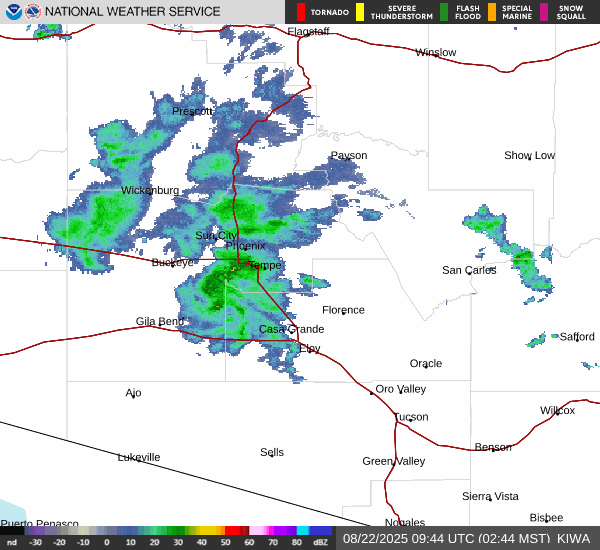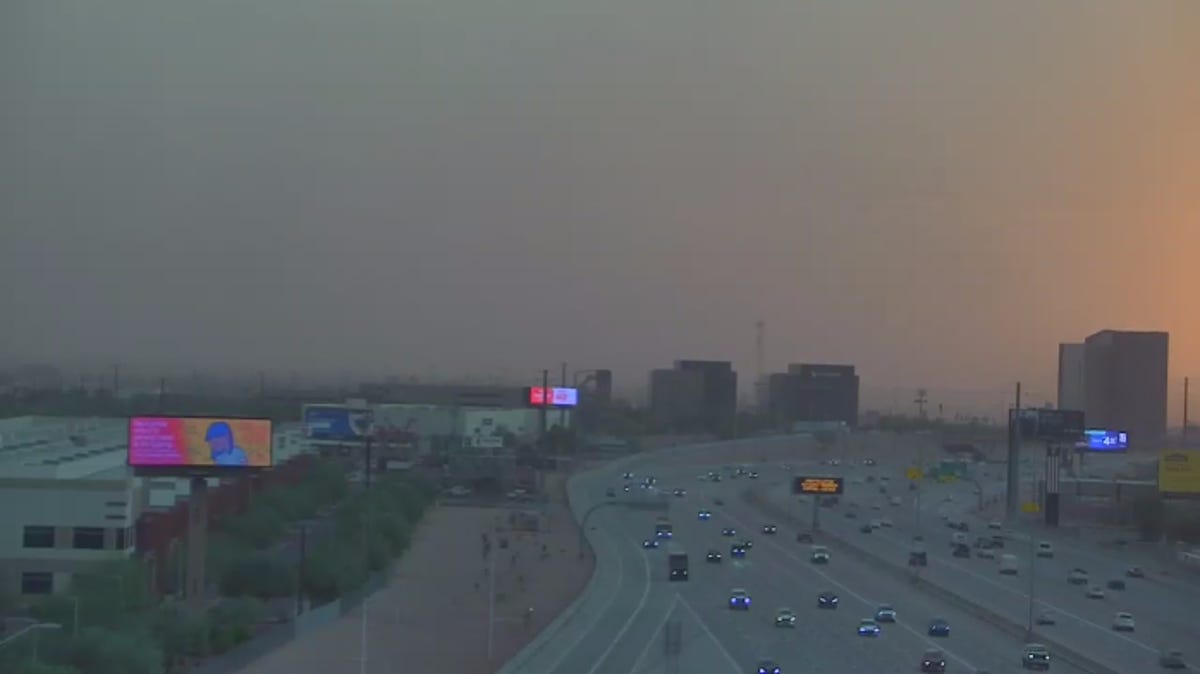Staff reports
| The Arizona Republic
The National Weather Service issued a dust storm warning for the Phoenix area through 10:45 p.m. Aug. 21.
At 9:40 p.m., a wall of dust was along a line extending from the Arizona State Fairgrounds to near Perryville to near Painted Rock Dam, moving north at 20 mph; there was less than a quarter-mile visibility with strong wind in excess of 40 mph.
Conditions mean dangerous, life-threatening travel, the weather service warned.
Locations impacted include Glendale, Surprise, Avondale, Goodyear, Buckeye, El Mirage, Tolleson, Youngtown, Sun City West, Waddell, Cashion, Sun City, Litchfield Park, Palo Verde, and White Tank Mountain Park.
This includes the following highways: Interstate 10 between mile markers 95 and 135; U.S. 60 between mile markers 131 and 148; Loop 101 between mile markers 2 and 8.
Also, as of 8 p.m., there were about 6,800 SRP customers without power. APS reported more than 3,000 customers were in the dark as of 8:35 p.m.
For the latest watches and warnings, see our weather alert page.
 Power outages from the storms
Power outages from the storms
Almost 7,000 Salt River Project customers had no power as of 8 p.m., according to an outage map.
More than 3,000 Arizona Public Service customers had lost power as of 8:35 p.m., according to an outage map.
What should I do in a dust storm if I am driving?
The Arizona Department of Transportation has helpful tips for drivers who may get stuck in a dust storm while driving. The “Pull Aside, Stay Alive” campaign aims to save drivers from dangerous situations by providing tips to survive a blowing dust event.
If you encounter a dust storm, immediately check traffic around your vehicle (front, back and to the side) and begin slowing down. Do not wait until poor visibility makes it difficult to safely pull off the roadway – do it as soon as possible. Completely exit the highway if you can.
Do not stop in a travel lane or in the emergency lane. Look for a safe place to pull completely off the paved portion of the roadway. Turn off all vehicle lights. You do not want other vehicles, approaching from behind, to use your lights as a guide and possibly crash into your parked vehicle.
Set your emergency brake and take your foot off the brake. Stay in the vehicle with your seat belt buckled and wait for the storm to pass.
Drivers of high-profile vehicles should be especially aware of changing weather conditions and travel at reduced speeds.
More information on dust storm safety can be found at PullAsideStayAlive.org And safety tips for driving in rainstorms can be found at azdot.gov/monsoon.
Tips for driving in the rain
The Arizona Department of Transportation provided the following safety tips for driving in the rain:
- Inspect windshield wipers and replace them if necessary prior to expected rainfall.
- Turn on the headlights.
- Reduce speeds.
- Avoid sudden braking on wet pavement.
- Create a “space cushion” between your vehicle and the vehicle in front of you.
- Avoid areas where water has pooled in travel lanes.
How to protect yourself from lightning strikes
Here are lightning safety tips from the National Weather Service:
- Pay attention to the weather. If you see big blue clouds, otherwise known as thunderheads, go inside. These types of clouds could mean a thunderstorm is coming.
- Get in a building with plumbing and wiring. If lightning strikes the building, the lightning will be conducted around and into the ground.
- Stay in your car. A vehicle will give you protection as electricity from lightning will pass through the vehicle’s structure instead of hitting you.
- Get off open water. A boat out on the water is likely to be the most prominent object and you could be struck.
- Do not shower or bathe. If lightning hits your pipes, it could be conducted into the water in your bath or shower.
- Do not use electric appliances with plugs or cords. Wireless cellphones are OK, as are laptops that are connected to Wi-Fi but not plugged in.
- Follow the 30-30 rule. If you hear thunder within 30 seconds of a lightning bolt, that means the thunderstorm’s distance is threatening. Wait at least 30 minutes after you hear the last thunder to go out. That gives the storm enough time to move away or dissipate.
- You don’t have to be near a storm to get struck. Lightning strikes can easily travel 10 miles or more. A record lightning flash in Oklahoma in 2007 traveled nearly 200 miles. Seek shelter if you hear thunder.
- Do not shelter under a tree. If lightning strikes the tree, the ground charge from the strike could travel into you.
- Don’t huddle in a group. If you are outdoors with friends or family during a thunderstorm, don’t all clump together. Keeping separation could reduce the number of people injured if lightning strikes.
(This story has been updated to add more information and a photo.)
This article was generated by The Arizona Republic and USA TODAY Network using data released by the National Weather Service. It was edited by a staff member.
